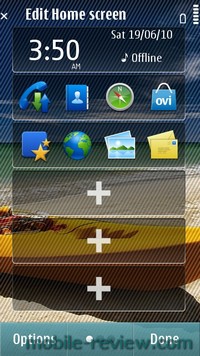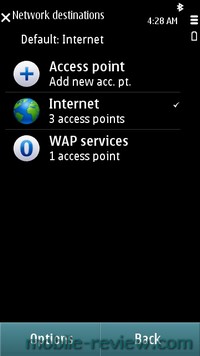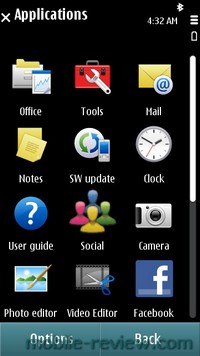That Symbian is the third to us preparing the example of the Nokia N8
In September, the Nokia N8 enters the market, it will be the first device in Europe with Symbian 3 (a polished version of the S60 5th edition). Until the second quarter of 2011, Nokia’s main touchscreen OS will be Symbian3 (S40 Touch) not counting. Then it will be replaced by the fundamentally updated Symbian4, which I like very much (different for Nokia, this is a big step forward, there is no novelty for the market). Considering that I have been using Symbian3 on several models in everyday life for a long time, I will try to briefly tell about what I like and what does not. What has changed and what has remained. The other day, Nokia released a pre-release version of the software for the Nokia N8, which means that there will be no critical changes in it. But this is not a review of the N8, although I will bring a couple of screenshots from it. Impressions, of course, with the N8 as the most finished device. A sort of mixture. Go.
What has changed in S3 compared to previous models?
')
- Supports field selection and one-touch information entry into it. If you had to select a field before, then click again to enter data, now this is not the case. The right decision, I like
- Synchronization with multiple calendars. A typical function for other operating systems, it is implemented here about the same. Conveniently. There is a combined look.
- Searching contacts when dialing a number is convenient, I don’t know why it wasn’t by default before.
- Search all phone and content. Same search application, only integrated otherwise. No major changes.
- Several desktops, plus widgets. A set of widgets are not particularly happy, they are familiar from the N97 and similar devices, a breakthrough did not happen. You can vary widgets in different places, run the same widget on multiple screens. The disadvantage is that the online widgets are sometimes restarted, as is done on all the latest Nokia devices (the screen flashes, the contents of the main screen are redrawn, apparently, this is done not to deal with memory leaks).
- USB host. Much has been said about this function, I will not repeat. Included is an adapter, you can connect your flash drive. It is visible in the file manager, you can upload files to and from the USB flash drive. In my device 32 GB of memory, which makes the use of flash drives is not very necessary. Simply throw files into memory, then copy to any computer using either a cable or BT. It is possible that someone will use this option often and will not forget to carry this adapter with them. But for me, the function is useless.
- Screen response (this is a software thing). When pressed, sometimes the device does not respond, this is a software problem. The same behavior in current models, for example, X6. It happens quite often, unlike the same iPhone.
- Icons and themes. You can change them handles, but why they look so old, for me remains a secret. A sort of past century. In this part of the menu is visible work to improve the appearance. The windows are rounded, not rectangular.
- Messages. You can choose a classic look, all messages are a list of the time of receipt. Or choose Conversations (in the form of chat).
- Access points. The ideology is exactly the same as before. Combined in groups, the point is selected that is available. Unfortunately, there are no improvements, so each time the necessary access point for each application is requested (you can set either a group for the application or one specific point). Sometimes it interferes with work. For example, if there is a WiFi connection that is already working, for example, in the browser, the device starts to break into mail using EDGE / 3G (in roaming it strains from the heart, the roaming warning works at the same time).
- Maps. Great version. I really like image autozoom, there are also a couple of minor improvements.
- The location of the programs in the menu. On three devices (different models), the icons are scattered in an arbitrary manner, that is, the same problem remains as before. We have to look for a calculator in the general menu, then in the Office section. It is clear that the problem is for those who use Nokia phones of different models.
- automatic backup creation on schedule. It's nice that there is such a function. It is unpleasant that time is not set when it occurs. For example, I can say with confidence that in the night it would be convenient. Sometimes it happens during the day and then, you take the phone in hand, and this application is launched.
- web. There are no special improvements, so the little things.
- Camera. Same interface.
- Gallery, it became more interesting, improved the speed of work (by default, icons of photos are created, which are then loaded from the cache, it works visually faster due to this).
- Games. Exactly the same. Although Nokia promises to show some separate toys, but in general there are no changes. Experience on S3 will be the same in terms of gaming platform. Well, not for games yet. Here on S4 there are significant improvements. There is no.
- The speed of work. There are practically no brakes, quite responsive interface. This is a plus. There are sometimes problems when loading pages with a flash in the browser, it starts to slow down everything shamelessly. It happens that when launching heavy applications, there are also problems, applications can still be closed arbitrarily in such cases, without any warnings. (I’ll make special reservation that these are prototypes, but all of Nokia’s commercial phones behave this way, so I think miracles will not happen). The stability is average, it’s not a buggy creation like the Nokia N97, but also not a device that never reboots. By requests for memory, applications, everything looks like the previous Symbian.
- Certificates. Everything remained as before. It is rather a minus. Your applications must be signed.
Dry residue .
Nokia has always said that S3 is a bug fix, but not the next version of the OS. So it happened. Removed minor issues, worked on the performance of individual functions. But nothing revolutionary happened. The same menus, the same impression of the interface (it does not seem to me very modern for the second half of 2010). This is an intermediate version between current models and S4, which is much more interesting and better in every sense. A good OS that does not have enough stars from the sky. If you are familiar with the current touch phones from Nokia, you can safely assume that you are familiar with S3. Perhaps something missed in his story, focused on the main points. At the weekend I sit and write a review, I hope that by the middle of the week I will finish it. There are all sorts of problems with third-party software, but by the time they exit, I hope that they will.





What has changed in S3 compared to previous models?
')
- Supports field selection and one-touch information entry into it. If you had to select a field before, then click again to enter data, now this is not the case. The right decision, I like
- Synchronization with multiple calendars. A typical function for other operating systems, it is implemented here about the same. Conveniently. There is a combined look.
- Searching contacts when dialing a number is convenient, I don’t know why it wasn’t by default before.
- Search all phone and content. Same search application, only integrated otherwise. No major changes.
- Several desktops, plus widgets. A set of widgets are not particularly happy, they are familiar from the N97 and similar devices, a breakthrough did not happen. You can vary widgets in different places, run the same widget on multiple screens. The disadvantage is that the online widgets are sometimes restarted, as is done on all the latest Nokia devices (the screen flashes, the contents of the main screen are redrawn, apparently, this is done not to deal with memory leaks).
- USB host. Much has been said about this function, I will not repeat. Included is an adapter, you can connect your flash drive. It is visible in the file manager, you can upload files to and from the USB flash drive. In my device 32 GB of memory, which makes the use of flash drives is not very necessary. Simply throw files into memory, then copy to any computer using either a cable or BT. It is possible that someone will use this option often and will not forget to carry this adapter with them. But for me, the function is useless.
- Screen response (this is a software thing). When pressed, sometimes the device does not respond, this is a software problem. The same behavior in current models, for example, X6. It happens quite often, unlike the same iPhone.
- Icons and themes. You can change them handles, but why they look so old, for me remains a secret. A sort of past century. In this part of the menu is visible work to improve the appearance. The windows are rounded, not rectangular.
- Messages. You can choose a classic look, all messages are a list of the time of receipt. Or choose Conversations (in the form of chat).
- Access points. The ideology is exactly the same as before. Combined in groups, the point is selected that is available. Unfortunately, there are no improvements, so each time the necessary access point for each application is requested (you can set either a group for the application or one specific point). Sometimes it interferes with work. For example, if there is a WiFi connection that is already working, for example, in the browser, the device starts to break into mail using EDGE / 3G (in roaming it strains from the heart, the roaming warning works at the same time).
- Maps. Great version. I really like image autozoom, there are also a couple of minor improvements.
- The location of the programs in the menu. On three devices (different models), the icons are scattered in an arbitrary manner, that is, the same problem remains as before. We have to look for a calculator in the general menu, then in the Office section. It is clear that the problem is for those who use Nokia phones of different models.
- automatic backup creation on schedule. It's nice that there is such a function. It is unpleasant that time is not set when it occurs. For example, I can say with confidence that in the night it would be convenient. Sometimes it happens during the day and then, you take the phone in hand, and this application is launched.
- web. There are no special improvements, so the little things.
- Camera. Same interface.
- Gallery, it became more interesting, improved the speed of work (by default, icons of photos are created, which are then loaded from the cache, it works visually faster due to this).
- Games. Exactly the same. Although Nokia promises to show some separate toys, but in general there are no changes. Experience on S3 will be the same in terms of gaming platform. Well, not for games yet. Here on S4 there are significant improvements. There is no.
- The speed of work. There are practically no brakes, quite responsive interface. This is a plus. There are sometimes problems when loading pages with a flash in the browser, it starts to slow down everything shamelessly. It happens that when launching heavy applications, there are also problems, applications can still be closed arbitrarily in such cases, without any warnings. (I’ll make special reservation that these are prototypes, but all of Nokia’s commercial phones behave this way, so I think miracles will not happen). The stability is average, it’s not a buggy creation like the Nokia N97, but also not a device that never reboots. By requests for memory, applications, everything looks like the previous Symbian.
- Certificates. Everything remained as before. It is rather a minus. Your applications must be signed.
Dry residue .
Nokia has always said that S3 is a bug fix, but not the next version of the OS. So it happened. Removed minor issues, worked on the performance of individual functions. But nothing revolutionary happened. The same menus, the same impression of the interface (it does not seem to me very modern for the second half of 2010). This is an intermediate version between current models and S4, which is much more interesting and better in every sense. A good OS that does not have enough stars from the sky. If you are familiar with the current touch phones from Nokia, you can safely assume that you are familiar with S3. Perhaps something missed in his story, focused on the main points. At the weekend I sit and write a review, I hope that by the middle of the week I will finish it. There are all sorts of problems with third-party software, but by the time they exit, I hope that they will.





Source: https://habr.com/ru/post/96905/
All Articles